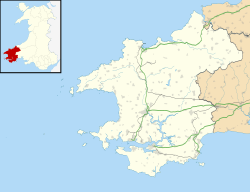| St Dogfael's Church, Meline | |
|---|---|
| Church of St Dogfael, Meline | |
 "An object lesson in High Victorian geometry" | |
| 52°00′55″N 4°44′38″W / 52.0152°N 4.7439°W | |
| Location | Meline, Pembrokeshire |
| Country | Wales |
| Denomination | Church in Wales |
| History | |
| Status | Redundant |
| Founded | 1864–1865 |
| Dedication | Saint Dogfael |
| Architecture | |
| Heritage designation | Grade II |
| Designated | 10 December 1997 |
| Architectural type | Church |
| Specifications | |
| Materials | Stone, slate roof |
The Church of St Dogfael, Meline, Pembrokeshire, Wales is a redundant church dating from the 19th century. A Grade II listed building, the church is now in the care of the Friends of Friendless Churches.
History and description
The church is dedicated to St Dogfael, and was built between 1864 and 1865. The architect was Robert Jewell Withers and the patron Sir Thomas Lloyd.[1] Lloyd, a landowner and Member of Parliament for Cardiganshire, claimed descent from the ancient Lords of Cemaes[2] and spent a considerable amount of his inheritance in pursuit of a peerage and in the construction of a number of buildings on his estate in a Gothic Revival style, including his home, Bronwydd Castle,[3] the court house at Felindre Farchog,[4] the restoration of the genuinely medieval castle at Newport[3] and the little church of St Dogfael.[a][5]
The church is small and simple. Lloyd, Orbach and Scourfield, in their Pembrokeshire volume of the Buildings of Wales Pevsner, describe it as "an object lesson in High Victorian geometry and minimal extraneous detail".[6] It is built of sandstone, with Bath stone dressings and a slate roof.[5] Constructed on the site of an earlier church,[1] the north doorway may a genuine Norman piece, or a later medieval one, from the original structure.[6][5] The church is a Grade II listed building[5] and, having been declared redundant, is now in the care of the charity, the Friends of Friendless Churches.[1]
Notes
References
- ^ a b c Meline, Friends of Friendless Churches, retrieved 6 December 2020
- ^ "The Death of Sir Thomas Lloyd". Cambrian News. 27 July 1877. p. 8. Retrieved 12 December 2020.
- ^ a b c Lloyd, Orbach & Scourfield 2004, pp. 318–321.
- ^ Lloyd, Orbach & Scourfield 2004, p. 185.
- ^ a b c d Cadw. "St Dogfael's, Meline (Grade II) (19167)". National Historic Assets of Wales. Retrieved 12 December 2020.
- ^ a b Lloyd, Orbach & Scourfield 2004, p. 284.
Sources
- Lloyd, Thomas; Orbach, Julian; Scourfield, Robert (2004). Pembrokeshire. The Buildings of Wales. New Haven, US and London: Yale University Press. ISBN 0300101783. OCLC 978065767.

